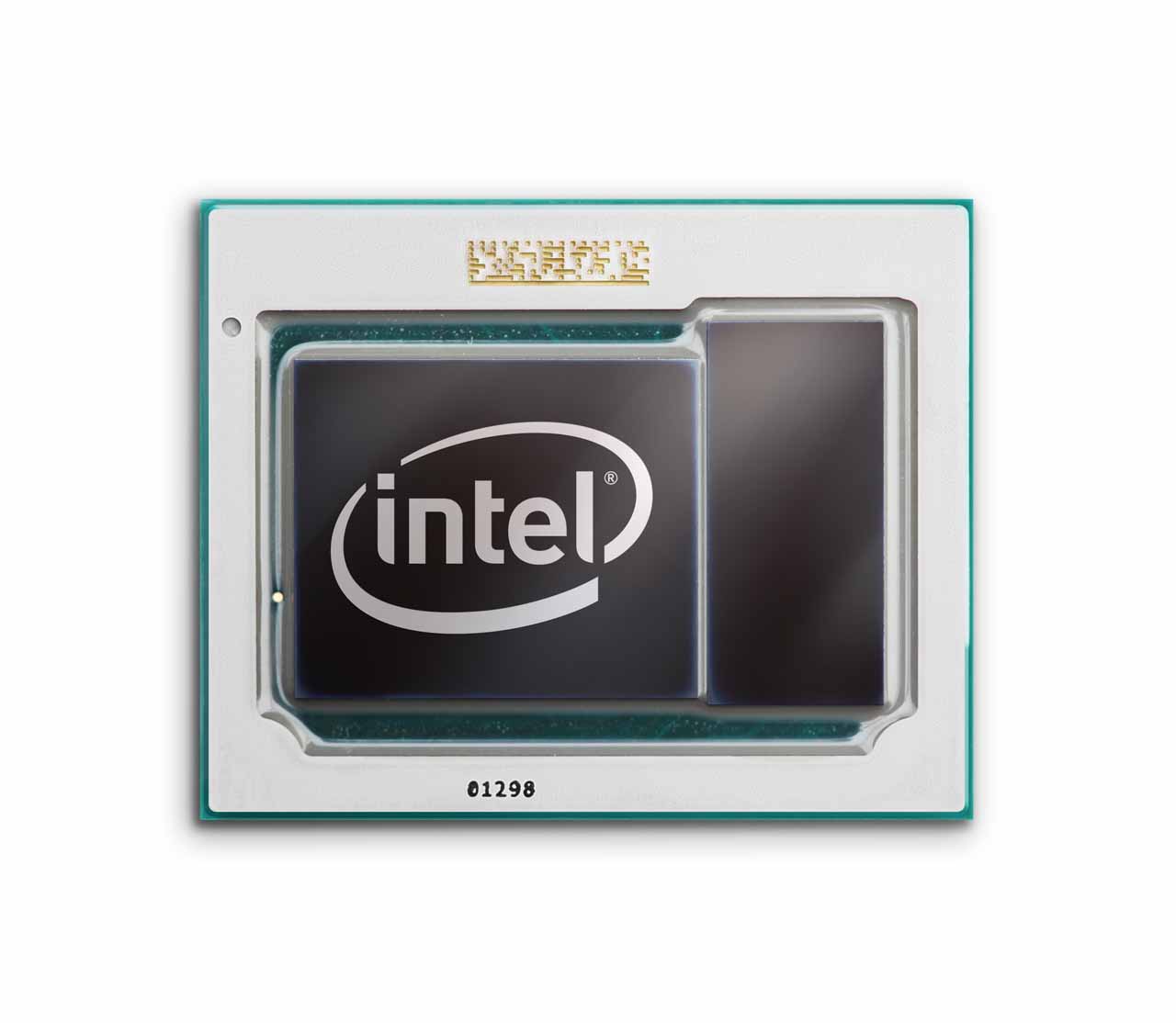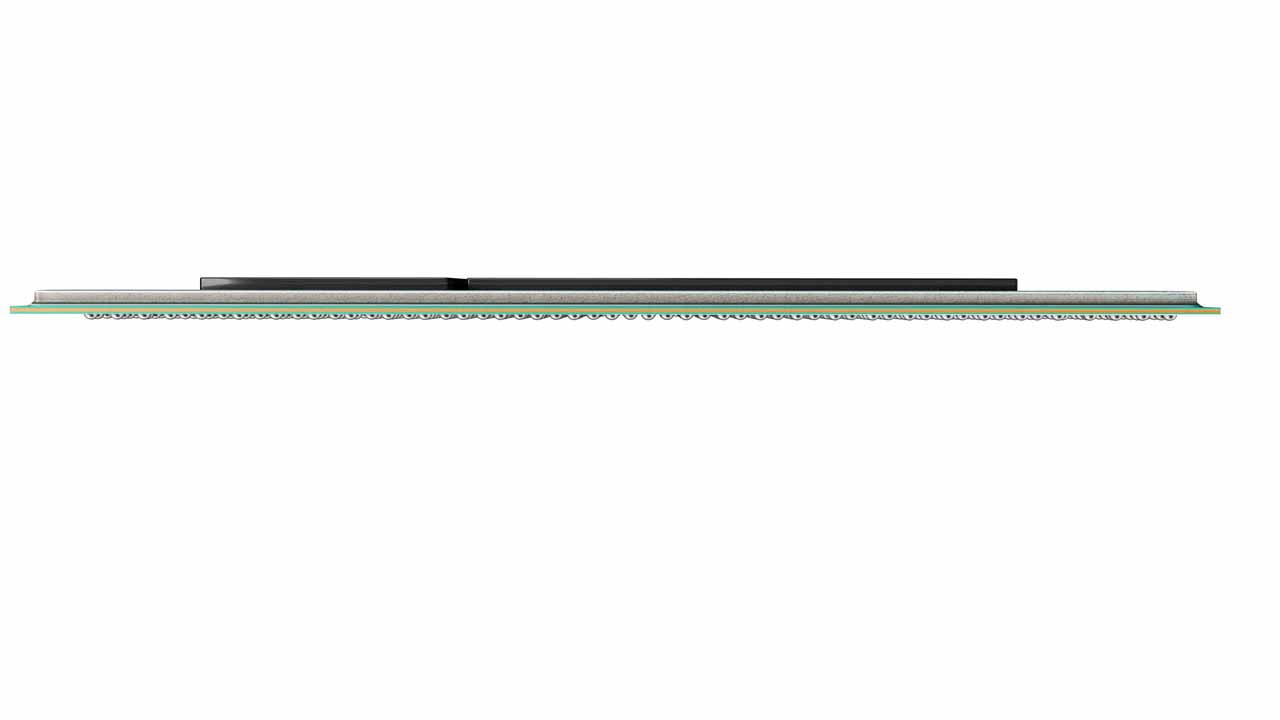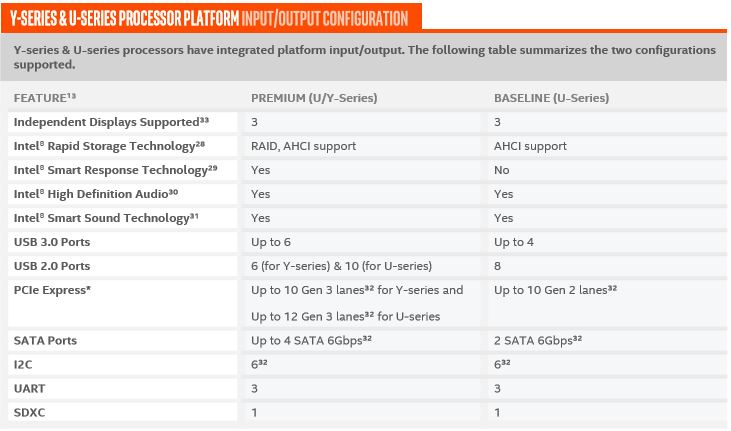Intel Kaby Lake: 14nm+, Higher Clocks, New Media Engine
The SKUs
Y-Series



Both the Y- and U-series processors feature a 2+2 configuration, which means that the processors employ two CPU cores and a Gen9+ HD Graphics 615 engine. The beefier SKUs with enhanced graphics cores will come to market early next year. Intel designed the 4.5W Y-series to address the thin and light segment.
| Y-Series Processors | 7th Gen Core i7 | 6th Gen Core m7 | 7th Gen Core i5 | 6th Gen Core m5 | 7th Gen Core m3 | 6th Gen Core m3 |
|---|---|---|---|---|---|---|
| Processor | i7-7Y75 | m7-6Y75 | i5-7Y54 | m5-6Y54 | m3-7Y30 | m3-6Y30 |
| Socket | FCBGA 1515 | FCBGA 1515 | FCBGA 1515 | FCBGA 1515 | FCBGA 1515 | FCBGA 1515 |
| Cores/Threads | 2/4 | 2/4 | 2/4 | 2/4 | 2/4 | 2/4 |
| Power | 4.5W | 4.5W | 4.5W | 4.5W | 4.5W | 4.5W |
| Base Frequency (GHz) | 1.3 | 1.2 | 1.2 | 1.1 | 1 | 0.9 |
| Max. Single-Core Frequency (GHz) | 3.6 | 3.1 | 3.2 | 2.7 | 2.6 | 2.2 |
| Max. Threaded Frequency (GHz) | 3.4 | 2.9 | 2.8 | 2.4 | 2.4 | 2 |
| Graphics | HD Graphics 615 | HD Graphics 515 | HD Graphics 615 | HD Graphics 515 | HD Graphics 615 | HD Graphics 515 |
| Graphics Base Frequency (MHz) | 300 | 300 | 300 | 300 | 300 | 300 |
| Max. Graphics Frequency (MHz) | 1050 | 1000 | 950 | 850 | 900 | 900 |
| Dual Memory Channel | LPDDR3/DDR3L 1866/1600 | LPDDR3/DDR3L 1866/1600 | LPDDR3/DDR3L 1866/1600 | LPDDR3/DDR3L 1866/1600 | LPDDR3/DDR3L 1866/1600 | LPDDR3/DDR3L 1866/1600 |
| Hyper-Threading | Yes | Yes | Yes | Yes | Yes | Yes |
| Smart Cache | Yes | Yes | Yes | Yes | Yes | Yes |
| Intel HD Graphics | Yes | Yes | Yes | Yes | Yes | Yes |
| Intel Active Management | Yes | Row 14 - Cell 2 | Yes | Row 14 - Cell 4 | No | Row 14 - Cell 6 |
| TSX-NI | Yes | Yes | Yes | No | No | No |
| Pricing - 1000 Units | $393 | $393 | $281 | $281 | $281 | $281 |
A glance at the spec sheet implies that little changes between the Skylake and Kaby Lake generations beyond core clock rates, but there are a number of other improvements under the hood, such as a bump from HD Graphics 515 to 615, which provides a nice boost to the max graphics frequency of the m3-7Y30 and i5-7Y54.
The relatively low CPU base frequency increase can be a bit misleading; mobility-focused products tend to employ lower base clock speeds to conserve battery life but provide higher Turbo Boost frequencies to enable a fast and flexible response to taxing workloads. The same trend continues with the seventh-gen products, though Intel did bump the base frequency up 100 MHz across the board compared to the previous generation.
The big performance increase comes in the form of single-core Turbo Boost speeds, which increase by 400-500 MHz. Turbo speeds are an important consideration for mobile use cases due to the need to satisfy instantaneous requests, then switching back down to a lower P-state. Intel also boosted the threaded Turbo Boost frequencies for the entire range.
All of the Y- and U-series products feature Hyper-Threading, and Turbo Boost 2.0 allows the CPU and GPU to scale clock rates based on workload intensity.
Intel also shook up its branding a bit: the Core m7 and Core m5 models experience a name change to i5 and i7.
U-Series
Intel aims the 15W U-series at higher-performance mobility applications, enabling the same 2+2 configuration with HD Graphics 620.
Get Tom's Hardware's best news and in-depth reviews, straight to your inbox.


| U-Series Processors | 7th Gen Core i7 | 6th Gen Core i7 | 7th Gen Core i5 | 6th Gen Core i5 | 7th Gen Core i3 | 6th Gen Core i3 |
|---|---|---|---|---|---|---|
| Processor | i7-7500U | i7-6500U | i5-7200U | i5-6200U | i3-7100U | i3-6100U |
| Socket | FCBGA 1356 | FCBGA 1356 | FCBGA 1356 | FCBGA 1356 | FCBGA 1356 | FCBGA 1356 |
| Cores/Threads | 2/4 | 2/4 | 2/4 | 2/4 | 2/4 | 2/4 |
| Power | 15W | 15W | 15W | 15W | 15W | 15W |
| Base Frequency (GHz) | 2.7 | 2.5 | 2.5 | 2.3 | 2.4 | 2.3 |
| Max. Single-Core Frequency (GHz) | 3.5 | 3.1 | 3.1 | 2.8 | N/A | N/A |
| Max. Threaded Frequency (GHz) | 3.5 | 2.6 | 3.1 | 2.4 | N/A | N/A |
| Graphics | HD Graphics 620 | HD Graphics 520 | HD Graphics 620 | HD Graphics 520 | HD Graphics 620 | HD Graphics 520 |
| Base Graphics Frequency (MHz) | 300 | 300 | 300 | 300 | 300 | 300 |
| Max. Graphics Frequency (MHz) | 1050 | 1050 | 1000 | 1000 | 100 | 1000 |
| Dual Memory Channel | DDR3L/DDR41866/2133 | DDR3L/DDR411600/2133LPDDR3-1866 | DDR3L/DDR41866/2133 | DDR3L/DDR411600/2133LPDDR3-1866 | DDR3L/DDR41866/2133 | DDR3L/DDR411600/2133LPDDR3-1866 |
| Hyper-Threading | Yes | Yes | Yes | Yes | Yes | Yes |
| Smart Cache | Yes | Yes | Yes | Yes | Yes | Yes |
| Intel HD Graphics | Yes | Yes | Yes | Yes | Yes | Yes |
| Intel Active Management | Yes | Row 14 - Cell 2 | Yes | Row 14 - Cell 4 | No | Row 14 - Cell 6 |
| TSX-NI | Yes | Yes | Yes | No | No | No |
| Pricing - 1000 Units | $393 | $393 | $281 | $281 | $281 | $281 |
The seventh-gen U-series bumps up the base frequency by 100-200 MHz and also features higher (300-400 MHz) Turbo Boost rates. The new platform also discards support for LPDDR3. Intel moves from HD Graphics 520 to 620, though its graphics engine clock rates remain static.
Kaby Lake's pricing is the same compared to Skylake SKUs. Intel indicated that it would ship vPro-enabled and Iris Pro (2+3 and 4+4) SKUs in January 2017.
Platform
Intel infused the majority of I/O features into the platform to reduce cost, complexity, and system-level power consumption, and because the processors use a BGA package, there aren't many differentiators. It should also go without saying that the BGA models are not a drop-in replacement for existing devices.
The baseline U-series does not support RAID or Intel Smart Response Technology, but the other features found on the premium lines remain, albeit in a reduced capacity. The premium products support up to 10 or 12 PCIe 3.0 lanes, while Intel restricts the baseline models to 10 PCIe 2.0 lanes. More devices are using the PCIe connection, such as speedy PCIe 3.0 x4 M.2 SSDs, so the lanes will find good use in most applications. The premium products also support a total of four 6 Gb/s SATA ports, while the baseline models only support two.
MORE: Best CPUs
MORE: Intel & AMD Processor Hierarchy
MORE: All CPU Content

Paul Alcorn is the Editor-in-Chief for Tom's Hardware US. He also writes news and reviews on CPUs, storage, and enterprise hardware.
-
ComputerSecurityGuy Yup, Skylake Refresh. Higher clocks. Slightly lower power consumption. Probably saw a demo of Overwatch on Iris Pro 680 (580 with 200mHz or so higher clocks. Overall, probably not a very interesting release. The only hopeful thing is they might bring Iris/Iris Pro to lower end or lower power SKUs.Reply -
80-watt Hamster Sheesh, why all the negativity? As someone who put together a Skylake platform with an i3, I'm looking forward to more capable -K processors being released for the same socket.Reply -
txhorn Kaby Lake's hardware encode and decode of 4k codecs is significantly better than Skylake. VP9 4k decode is down to 10-20% cpu usage from 70-80% usage. That's pretty awesome for HTPC's and high-res portable battery life.Reply -
AndrewJacksonZA Typo on page two: "Intel is optimizing its transistors by improving their fin profile with taller fins and a wider gate pitch" That should be a NARROWER gate pitch.Reply -
goblinissimus Nothing about USB 3.1 Gen 2, TB3, DP1.3, HDMI 2.0b/HDCP 2.2?Reply
Also, 12 bit (aka Dolby Vision or DV) HEVC decode would have been nice. -
digitalgriffin You know intel keeps bragging about how you get more battery life. Yet manufacturers keep shrinking the Wh on the batteries and intel keeps raising their prices. You really gain nothing in terms of battery life or cost.Reply -
80-watt Hamster Reply18520394 said:$389 for a 2 core 4 thread processor....thanks but no thanks.
4C8T perhaps you mean? I can't see Intel trying to charge nearly $400 for an i3.
